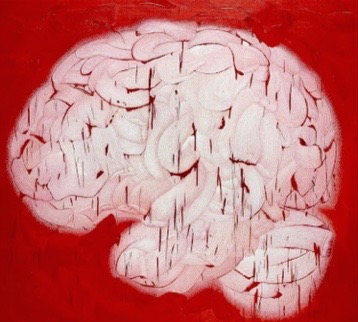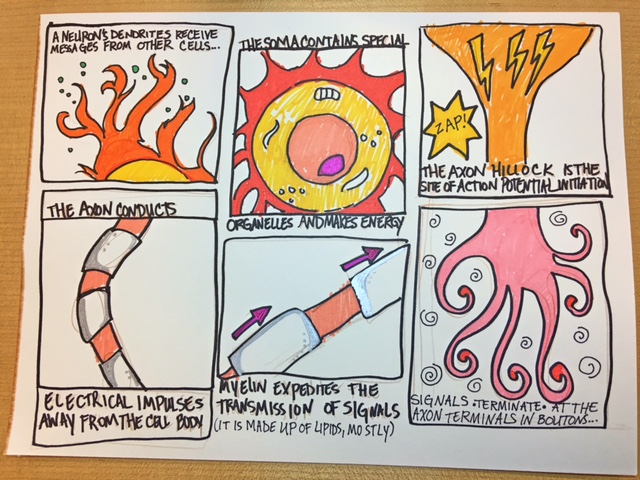The brain (2004), by South Korean artist Myung Su Ham…
The young adult brain is made up of some 86 billion cells, called neurons, that carry information in the form of electric current. Where one neuron ends (at the end of a wire-like extension off the cell body, called the axon), it converts that electric current into the release of a chemical neurotransmitter, which can excite or inhibit the next neuron in the chain.
In this way, neurons are linked into distributed networks, that transmit sensory information to nets of interconnected neurons in the brain – where perceptual experience and planning for behavior take place.
Drawing by Brianna Jacobs, Noggin Resource Council
MAKE A PIPE CLEANER NEURON
DISCOVER: Pipe Cleaner Neuron Project Background
CREATE: How to make a pipe cleaner neuron
WATCH: Making pipe cleaner neurons in the classroom
PRINT SLIDES FOR VIDEOS: Electrical properties of neurons
So what is an electrical current?
Electrical currents are moving streams of charged particles, and neurons use sodium (Na+) and potassium (K+) ions to carry currents.
But why do ions move?
A number of forces contribute to the movement of charged particles, Including ions like Na+ and K+.
How is a neuron set up to carry an electrical message, should the conditions arise?
BEFORE a neuron sends an electrical message, it maintains a “resting potential”
Neurons are at the “resting potential” (a charge difference across the membrane of around -65mV), before they send any sort of electrical message. That specific difference in charge (-65mV) is a certain level of polarization (difference). But that charge difference can change, if ions move across the membrane. The charge difference can get smaller (depolarization), or bigger (hyperpolarization).
We’ll see that depolarization leads to an action potential, while hyperpolarization inhibits action potentials.
How does depolarization lead to an action potential?
Depolarization (from -65mV to the “threshold” potential of -55mV) causes voltage-gated Na+ channels to swing open, letting a flood of Na+ ions into the neuron. Many sensory neurons respond to specific stimuli by coupling detection to depolarization, and the initiation of an action potential…
Voltage-gated K+ channels also open at the threshold potential, in response to depolarization.
The exiting of positively charged K+ ions contributes to the “repolarization” of the neuron – the return to the resting potential so it can fire another action potential again.
Summary of the action potential

Watch this video AFTER you have watched the other videos on the resting potential, and the action potential. Hopefully, it will help put the entire process together in a reasonably accessible way 🙂

Remember that action potentials occur upon depolarization from rest (-65mV) to threshold (-55mV), because that’s when voltage-gated Na+ channels swing open their gates to let Na+ ions in. And that rushing current of Na+ is an information-rich message. Different types of sensory neurons detect different types of stimuli, typically by coupling detection of the stimulus to depolarization, and current flow.
Then the depolarization arrives at the axon terminal.









